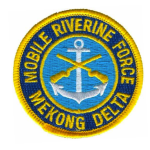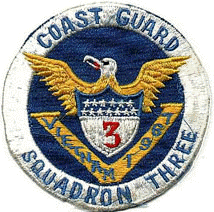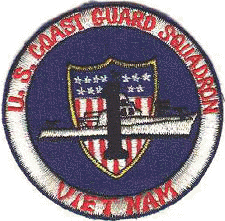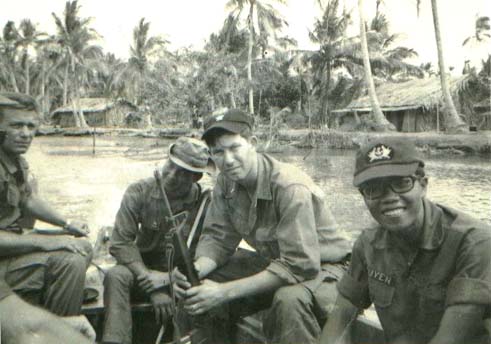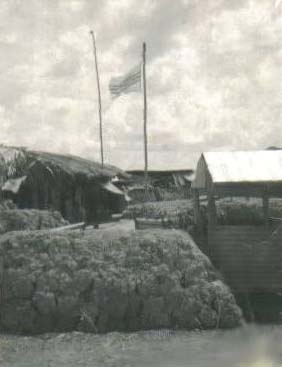The above photos and the story below entitled “Recollections of the Song Ong Doc” are provided by David Desiderio.
“Recollections of the Song Ong Doc” by David Desiderio
An event I’d like to share from Vietnam was when our MEDCAP team from the Coast Guard Cutter Pontchartrain (myself and our 1st Class Corpsman) stayed aboard the AMMIs at Song Ong Doc in late April and early May of ’70. One afternoon in late April we were ferried by the cutter’s small boat to the ATSB, and spent the night there. The following morning we were ferried about 10 clicks upriver to “old” Song Ong Doc aboard PBRs to join up with two MACV Army guys, a MSGT and, as I recall, a SFC.
After dropping us off at “old” SOD, the PBRs either went back down river to “new” SOD, or on patrol, I don’t know which. We went on to our destination with the Army guys via “Boston Whaler”. We left “old” SOD and turned South on some narrow canal in the direction of what some call “VC Lake” on the Song Dong Cung. I remember at one point in the transit we all had to get out of the boat, drag it up over an earthen dam, and back down to the canal to continue our journey. We arrived at some kind of compound, a PF outpost I suppose; the Corpsman, who unfortunately had a case of the “trots” was cautioned to be careful where he stepped on the way to the latrine, and not to step off of the path due to the jerry-rigged booby traps that were seeded in the area.
At the compound we treated numerous locals for various ailments, most of which seemed fairly routine; I do remember seeing one youngster with a horribly cleft palate – nothing to be done for him – and another individual who was firmly advised by the HM1 and the MSGT to go to Saigon for treatment – for what exactly, I don’t remember. It seemed to me, from where we were, the poor soul might just as well have been told to go to New York, but I guess they had a way of getting around the country.
After seeing everyone who needed to be seen, we were treated to a big chicken dinner. I noticed that there weren’t quite as many chickens running around as there were when we arrived. It was a very good meal, and for beverages we had some kind of homemade “wine”. They called it by a name I won’t attempt to spell, but it sounded like “BAH SEE DAY”. As I recall, it was pinkish in color and had quite a bit of pulp in it, so I drank it by trying to strain it through my teeth. At one point, I remember feeling a remarkably
large piece in my mouth, so I pulled it out. It turned out to be a huge, ugly black fly, that had obviously drank himself to death.
After the meal, we headed back to “old” SOD, via the same route we came. A VNN Thuy Uy bummed a ride with us, and he had really been into the “BAH XE DE”. He was so drunk he almost capsized the boat, and the MSGT threatened to shoot him if he didn’t settle down. He settled down, and we returned safely. We disembarked from the Boston Whaler at “old” SOD at a slightly different location from where we had embarked. It was a mud-bog, and I think the Army guys just wanted to see us get muddy, at least up to our knees.
After the PBRs picked us up at “old” SOD and got us back to the ATSB at “new” SOD, we expected to have Pontchartrain’s small boat waiting to take us back to the cutter. Not to be. While we were away, the cutter had received orders to proceed to the vicinity of Ha Tien on the Cambodian border for an emergency NGFS mission. This was at the time of the “Cambodian incursion”, and I assume it might have been connected to those operations. The crew later related how the cutter had to crawl up into that very shallow part of the Gulf with the small boat out ahead using a lead-line. So, we ended up
being “guests” of the good folks at the ATSB for several days.
(About six weeks later, a MEDCAP team from the USCGC Yakutat was ambushed halfway between “new” SOD and “old” SOD – they took a few B-40 rounds – but fortunately there were no personnel casualties).
We stayed in a barracks barge that was occupied by members of a platoon (the 6th, I think) from Seal Team Two. Nice guys that they were, they invited me to go along with them on an “R&R” trip up to Ca Mau City. Of course, I accepted. We went up in a STAB, and it didn’t seem like it took any time at all to get there, the STAB being powered by (I believe) twin Chevy 396 c.i. engines. I noticed that these guys were a little less formal insofar as the uniform of the day was concerned. When transiting in the PBRs, flak-jackets and battle-helmets seemed to be SOP. A couple of these SEAL guys were
sunning themselves on the way up wearing nothing but Navy issue swim shorts. It brought to mind the motto of my Dad’s Regiment in Korea, the 27th RCT “Wolfhounds” – Nec Aspera Terrent – (roughly: “No Fear”).
Eventually, we had to turn East or Southeast into a canal off of the Song Ong Doc to get to the town, and we had much fun making a big wake and pissing off everyone on the bank. The showboating had a cost, though. After a few hours of liberty in town, and expecting to get back to the ATSB in about the same time it took to get to Ca Mau, it soon became apparent that sea suction for the cooling of both engines on the STAB had sucked in so much debris from the shallow canal that the engines were overheating. We ended up with the port engine shut down, idling back on the starboard engine for the entire 35 clicks, in the dark, with only the “heads up” radar to go by. That was the night of 30 April 1970, and, although there seemed to be some activity on the North side of the river that night, judging by the numerous illumination flares and tracers, our transit was uneventful. After returning to the ATSB, we swallowed a few extra beers.
I don’t remember exactly how many days we waited for Pontchartrain to return. It was a few, anyway. I remember the chow at the ATSB was good. I particularly remember what I call “American Chop Suey” – macaroni noodles and hamburger all mixed up. I love that stuff, especially with Tabasco sauce. On the “other end” of things, the latrine was quite primitive. As I recall, there was a “four holer” on the downstream end of the inboard AMMI. Anything voided dropped right into the river, and naturally, when using the facility it is to be expected to hear the resulting “splash”. Well, that’s precisely what happened the first time I used it, except after the expected initial “splash” I began to hear “secondaries”. Jumping up and looking down through the hole, I saw a foot-long fish wrestling with his “dinner”. I made a mental note to avoid any recreational fishing.
One evening, the SEALS were going out to call on some local area VC cadre, and since I had nothing better to do, I asked if I could go along. Fortunately, they had enough good sense to persuade me that it would be better for all concerned if I stayed aboard to watch the fort and have a few beers. This leads me to another point, one I need to get off my chest. The beer I drank was from the Seal Team’s fund, and I carefully checked off the tally sheet for each one I took so that I could pay for them. I payed when I left, but later my XO told me that I had only paid the “wholesale” price, and that I still owed the Seals for the difference. I never had a chance to make good on that, but if there are any members of MRFA from Seal Team Two, please ask them where I can send a donation to their morale fund.
After returning to Pontchartrain, we bounced back and forth over the Summer and Fall between Market Time Areas Two and Nine, inspecting junks and providing gunfire support. We fired in support of Marines in and around Chu Lai, and in support of the Americal Division in Quang Ngai near Mui Batangan. As I recall, on one occasion we were using some 5″/38 RAP in Quang Ngai, and the rocket boosters were igniting over the heads of the Army guys, and they got rather irate, thinking that it was VT Frag and we were trying to kill them. Once it was explained what we were doing, it was OK.
Pontchartrain fired a total of 4,048 rounds of 5″/38 in NGFS during her deployment. Missions included “Dufflebag”, “Red Haze”, as well as “spotted”, at all hours night and day. She was sporting her third gun barrel when she departed, the first having been shot out, and the second suffering a “rung” bore due to a defective lot of ammo. Maybe we had a Guardian Angel, because when we were on line there were no disasters – neither ashore nor onboard. We had a “rung” barrel, but the USS Lloyd Thomas (DD 764) had an inbore explosion in her MT 51 from defective ammo that cost many lives. And… Thank God… we never had a “blue-on-blue” incident.
We departed Area Nine on 12 September 1970 for the last time. Later, we heard that two Seawolf helos had been shot down near “VC Lake” a couple of days after we left. Our final Market Time Patrol was from 3 October to 25 October 1970 in Area Eight. It was the only time we actually patrolled in Area Eight. While we were taking pictures on Paolo Obi, visiting the Loran Station on Con Son, and taking joyrides on the Asheville class PG in the area (I forget which one) – the ATSB at Song Ong Doc was being destroyed by the enemy. The USCGC Bering Strait (WHEC 382) was the cutter on scene in Area Nine, and I’m sure Pontchartrain couldn’t have done anything more, or anything better than Bering Strait. But I’ll always regret not having had the opportunity to try.
For Further Information on the Coast Guard in Vietnam, see Ken Laesser’s Coast Guard video HERE.



